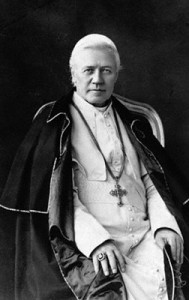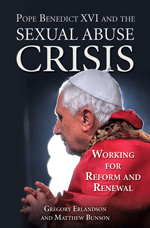Part 2 of the discussion with Gregory Erlandson. Pope Benedict XVI and the Sexual Abuse Scandal is an important contribution to the understanding and healing of the great heartache that has inflicted the Church over the last 30 years. Talking with Gregory Erlandson was a great opportunity to realize the nuisances of what got us here, but also the response and hope that leads us to the future.
[powerpress]
Tags: catholic, catholic podcast, catholic prayer, cathollc spirituality, Church, Gregory Erlandson, hope, osv, our sunday visitor, pope benedict xvi, Sexual Abuse Scandal
This entry was posted on Thursday, September 9th, 2010 at 11:08 pm
You can follow any responses to this entry through the RSS 2.0 feed.
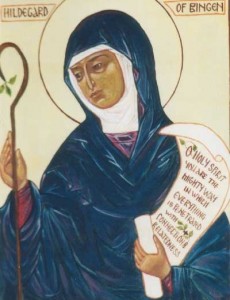 Once again the Holy Father, Pope Benedict XVI speaks of the importance of St. Hildegard of Bingen.
Once again the Holy Father, Pope Benedict XVI speaks of the importance of St. Hildegard of Bingen.
Vatican City – Pope Benedict’s General Audience from Vatican.va
Dear Brothers and Sisters, Today I would like to take up and continue my Reflection on St Hildegard of Bingen, an important female figure of the Middle Ages who was distinguished for her spiritual wisdom and the holiness of her life. Hildegard’s mystical visions resemble those of the Old Testament prophets: expressing herself in the cultural and religious categories of her time, she interpreted the Sacred Scriptures in the light of God, applying them to the various circumstances of life. Thus all those who heard her felt the need to live a consistent and committed Christian lifestyle. In a letter to St Bernard the mystic from the Rhineland confesses: “The vision fascinates my whole being: I do not see with the eyes of the body but it appears to me in the spirit of the mysteries…. I recognize the deep meaning of what is expounded on in the Psalter, in the Gospels and in other books, which have been shown to me in the vision. This vision burns like a flame in my breast and in my soul and teaches me to understand the text profoundly” (Epistolarium pars prima I-XC: CCCM 91). Hildegard’s mystical visions have a rich theological content. They refer to the principal events of salvation history, and use a language for the most part poetic and symbolic. For example, in her best known work entitled Scivias, that is, “You know the ways” she sums up in 35 visions the events of the history of salvation from the creation of the world to the end of time. With the characteristic traits of feminine sensitivity, Hildegard develops at the very heart of her work the theme of the mysterious marriage between God and humanity that is brought about in the Incarnation. On the tree of the Cross take place the nuptials of the Son of God with the Church, his Bride, filled with grace and the ability to give new children to God, in the love of the Holy Spirit (cf. Visio tertia: PL 197, 453c).
From these brief references we already see that theology too can receive a special contribution from women because they are able to talk about God and the mysteries of faith using their own particular intelligence and sensitivity. I therefore encourage all those who carry out this service to do it with a profound ecclesial spirit, nourishing their own reflection with prayer and looking to the great riches, not yet fully explored, of the medieval mystic tradition, especially that represented by luminous models such as Hildegard of Bingen.
The Rhenish mystic is also the author of other writings, two of which are particularly important since, like Scivias, they record her mystical visions: they are the Liber vitae meritorum (Book of the merits of life) and the Liber divinorum operum (Book of the divine works), also called De operatione Dei. In the former she describes a unique and powerful vision of God who gives life to the cosmos with his power and his light. Hildegard stresses the deep relationship that exists between man and God and reminds us that the whole creation, of which man is the summit, receives life from the Trinity. The work is centred on the relationship between virtue and vice, which is why human beings must face the daily challenge of vice that distances them on their way towards God and of virtue that benefits them. The invitation is to distance themselves from evil in order to glorify God and, after a virtuous existence, enter the life that consists “wholly of joy”. In her second work that many consider her masterpiece she once again describes creation in its relationship with God and the centrality of the human being, expressing a strong Christo-centrism with a biblical-Patristic flavour. The Saint, who presents five visions inspired by the Prologue of the Gospel according to St John, cites the words of the Son to the Father: “The whole task that you wanted and entrusted to me I have carried out successfully, and so here I am in you and you in me and we are one” (Pars III, Visio X: PL 197, 1025a). Finally, in other writings Hildegard manifests the versatility of interests and cultural vivacity of the female monasteries of the Middle Ages, in a manner contrary to the prejudices which still weighed on that period. Hildegard took an interest in medicine and in the natural sciences as well as in music, since she was endowed with artistic talent. Thus she composed hymns, antiphons and songs, gathered under the title: Symphonia Harmoniae Caelestium Revelationum (Symphony of the Harmony of Heavenly Revelations), that were performed joyously in her monasteries, spreading an atmosphere of tranquillity and that have also come down to us. For her, the entire creation is a symphony of the Holy Spirit who is in himself joy and jubilation.
The popularity that surrounded Hildegard impelled many people to seek her advice. It is for this reason that we have so many of her letters at our disposal. Many male and female monastic communities turned to her, as well as Bishops and Abbots. And many of her answers still apply for us. For instance, Hildegard wrote these words to a community of women religious: “The spiritual life must be tended with great dedication. At first the effort is burdensome because it demands the renunciation of caprices of the pleasures of the flesh and of other such things. But if she lets herself be enthralled by holiness a holy soul will find even contempt for the world sweet and lovable. All that is needed is to take care that the soul does not shrivel” (E. Gronau, Hildegard. Vita di una donna profetica alle origini dell’età moderna, Milan 1996, p. 402). And when the Emperor Frederic Barbarossa caused a schism in the Church by supporting at least three anti-popes against Alexander iii, the legitimate Pope, Hildegard did not hesitate, inspired by her visions, to remind him that even he, the Emperor, was subject to God’s judgement. With fearlessness, a feature of every prophet, she wrote to the Emperor these words as spoken by God: “You will be sorry for this wicked conduct of the godless who despise me! Listen, O King, if you wish to live! Otherwise my sword will pierce you!” (ibid., p. 412). With the spiritual authority with which she was endowed, in the last years of her life Hildegard set out on journeys, despite her advanced age and the uncomfortable conditions of travel, in order to speak to the people of God. They all listened willingly, even when she spoke severely: they considered her a messenger sent by God. She called above all the monastic communities and the clergy to a life in conformity with their vocation. In a special way Hildegard countered the movement of German cátari (Cathars). They cátari means literally “pure” advocated a radical reform of the Church, especially to combat the abuses of the clergy.
She harshly reprimanded them for seeking to subvert the very nature of the Church, reminding them that a true renewal of the ecclesial community is obtained with a sincere spirit of repentance and a demanding process of conversion, rather than with a change of structures. This is a message that we should never forget. Let us always invoke the Holy Spirit, so that he may inspire in the Church holy and courageous women, like St Hildegard of Bingen, who, developing the gifts they have received from God, make their own special and valuable contribution to the spiritual development of our communities and of the Church in our time.
Tags: catholic, catholic podcast, catholic prayer, cathollc spirituality, Church, courageous women, Hildegard of Bingen, holy spirit, mysteries, mystic of the Church, mystics, pope benedict, pope benedict xvi, st hildegard of bingen, women, women of the middle ages
This entry was posted on Wednesday, September 8th, 2010 at 4:08 pm
You can follow any responses to this entry through the RSS 2.0 feed.
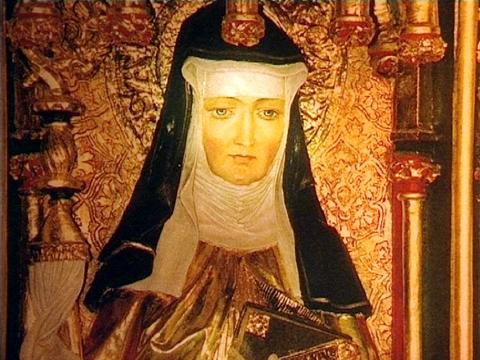 St. Hildegard was a woman who was a great mystic, writer, poet, musician, artist and a devout Benedictine nun!   She valued the hierachy and authority of the Church, and even sought counsel and received validation from the great mystical doctor of the Church, St. Bernard of Clairvaux.Â
St. Hildegard was a woman who was a great mystic, writer, poet, musician, artist and a devout Benedictine nun!   She valued the hierachy and authority of the Church, and even sought counsel and received validation from the great mystical doctor of the Church, St. Bernard of Clairvaux.Â
Papal Summer Residence, Castel Gandolfo
Wednesday, 1st September 2010“Saint Hildegard of Bingen
Dear Brothers and Sisters,
In 1988, on the occasion of the Marian Year, Venerable John Paul II wrote an Apostolic Letter entitled Mulieris Dignitatem on the precious role that women have played and play in the life of the Church. “The Church”, one reads in it, “gives thanks for all the manifestations of the feminine “genius’ which have appeared in the course of history, in the midst of all peoples and nations; she gives thanks for all the charisms that the Holy Spirit distributes to women in the history of the People of God, for all the victories which she owes to their faith, hope and charity: she gives thanks for all the fruits of feminine holiness” (n. 31).
Various female figures stand out for the holiness of their lives and the wealth of their teaching even in those centuries of history that we usually call the Middle Ages. Today I would like to begin to present one of them to you: St Hildegard of Bingen, who lived in Germany in the 12th century. She was born in 1098, probably at Bermersheim, Rhineland, not far from Alzey, and died in 1179 at the age of 81, in spite of having always been in poor health. Hildegard belonged to a large noble family and her parents dedicated her to God from birth for his service. At the age of eight she was offered for the religious state (in accordance with the Rule of St Benedict, chapter 59), and, to ensure that she received an appropriate human and Christian formation, she was entrusted to the care of the consecrated widow Uda of Gölklheim and then to Jutta of Spanheim who had taken the veil at the Benedictine Monastery of St Disibodenberg. A small cloistered women’s monastery was developing there that followed the Rule of St Benedict. Hildegard was clothed by Bishop Otto of Bamberg and in 1136, upon the death of Mother Jutta who had become the community magistra (Prioress), the sisters chose Hildegard to succeed her. She fulfilled this office making the most of her gifts as a woman of culture and of lofty spirituality, capable of dealing competently with the organizational aspects of cloistered life. A few years later, partly because of the increasing number of young women who were knocking at the monastery door, Hildegard broke away from the dominating male monastery of St Disibodenburg with her community, taking it to Bingen, calling it after St Rupert and here she spent the rest of her days. Her manner of exercising the ministry of authority is an example for every religious community: she inspired holy emulation in the practice of good to such an extent that, as time was to tell, both the mother and her daughters competed in mutual esteem and in serving each other.
During the years when she was superior of the Monastery of St Disibodenberg, Hildegard began to dictate the mystical visions that she had been receiving for some time to the monk Volmar, her spiritual director, and to Richardis di Strade, her secretary, a sister of whom she was very fond. As always happens in the life of true mystics, Hildegard too wanted to put herself under the authority of wise people to discern the origin of her visions, fearing that they were the product of illusions and did not come from God. She thus turned to a person who was most highly esteemed in the Church in those times: St Bernard of Clairvaux, of whom I have already spoken in several Catecheses. He calmed and encouraged Hildegard. However, in 1147 she received a further, very important approval. Pope Eugene iii, who was presiding at a Synod in Trier, read a text dictated by Hildegard presented to him by Archbishop Henry of Mainz. The Pope authorized the mystic to write down her visions and to speak in public. From that moment Hildegard’s spiritual prestige continued to grow so that her contemporaries called her the “Teutonic prophetess”.
This, dear friends, is the seal of an authentic experience of the Holy Spirit, the source of every charism: the person endowed with supernatural gifts never boasts of them, never flaunts them and, above all, shows complete obedience to the ecclesial authority. Every gift bestowed by the Holy Spirit, is in fact intended for the edification of the Church and the Church, through her Pastors, recognizes its authenticity.
I shall speak again next Wednesday about this great woman, this “prophetess” who also speaks with great timeliness to us today, with her courageous ability to discern the signs of the times, her love for creation, her medicine, her poetry, her music, which today has been reconstructed, her love for Christ and for his Church which was suffering in that period too, wounded also in that time by the sins of both priests and lay people, and far better loved as the Body of Christ. Thus St Hildegard speaks to us; we shall speak of her again next Wednesday. Thank you for your attention.”
God is the foundation for everything
This God undertakes, God gives.
Such that nothing that is necessary for life is lacking.
Now humankind needs a body that at all times honors and praises God.
This body is supported in every way through the earth.
Thus the earth glorifies the power of God.
Visit the Discerning Hearts
St. Hildegard von Bingen page
for more on this Doctor of the Church
Tags: Anglican Episcopal, catholic, catholic podcast, catholic prayer, cathollc spirituality, Church, holy father, Matthew Fox, mystic, mystic of the Church, mystical visions, New Agers, st bernard of clairvaux, st hildegard of bingen, st. hildegarde, Vatican Information Service, women of the middle ages
This entry was posted on Thursday, September 2nd, 2010 at 3:14 pm
You can follow any responses to this entry through the RSS 2.0 feed.
The Pope of the Blessed Sacrament
“Itching Ears Among Us
Saint Pius X exemplified the words of the Apostle to Timothy: “Preach the word, be urgent in season and out of season, convince, rebuke, and exhort, be unfailing in patience and in teaching. For the time is coming when people will not endure sound teaching, but having itching ears they will accumulate for themselves teachers to suit their own likings, and will turn away from listening to the truth and wander into myths†(2 Tim 4:2–4). One hundred years after Pope Saint Pius X we have to ask ourselves if there are not still “itching ears†among us.
What causes one’s ears to itch? Curiosity. Lack of discernment. A weak background in Catholic doctrine. Faithful Catholics cannot permit themselves to read just anything. To read authors of dubious orthodoxy or authors critical of the Magisterium is like scratching an itch. It becomes worse. Why would one would even want to read such authors when one can choose from among the inexhaustible richness of the writings of the saints of every age?
It was Saint Pius X who opened Holy Communion to little children. He invited the Catholic faithful to frequent, even daily Holy Communion. Pius X came to be known as the “Pope of the Eucharist,†a title that he now shares with Pope John Paul II, the author of Ecclesia de Eucharistia and of Mane Nobiscum, Domine.” – for more go to Vultus Christi
I see that serious face of the young boy to the right, and I wonder what he is thinking. His family was so poor. Giuseppe Melchiorre Sarto was born in 1835, the second of ten children. His father was the village postman. Though poor, his parents valued education and made every effort in securing that gift for their children.
Pope Pius was a Marian Pope, whose encyclical Ad Diem Illum expresses his desire through Mary to renew all things in Christ, which he had defined as his motto in his first encyclical. Pius believed that there is no surer or more direct road than by Mary to achieve this goal (no wonder he had such a beautiful heart). Pius X was the only Pope in the 20th century with extensive pastoral experience at the parish level, and pastoral concerns permeated his papacy; he favoured the use of the vernacular in catechesis. Frequent communion was a lasting innovation of his papacy. He spoke plainly and with strength, and because of that he was not well like by the elite and the rich.  He often referred to his own humble origins, taking up the causes of poor people. I was born poor, I have lived poor, and I wish to die poor
This is a wonderful prayer by the saint himself:
O Lord Jesus Christ, let Your passion be my strength to sustain, guard, and protect me. Let Your wounds be my food and drink to nourish, fill, and invigorate me. Let the shedding of Your Blood cleanse me of all my sins. Let Your death obtain eternal life for me and Your cross lead me to everlasting glory. Let these constitute for me refreshment and joy, health and uprightness of heart.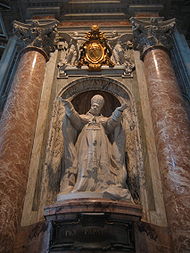 Â Â Amen.
  Amen.
Tags: Ad Diem Illum, catholic, catholic doctrine, catholic podcast, catholic prayer, cathollc spirituality, children, eternal life, holy communion, pope saint pius x
This entry was posted on Saturday, August 21st, 2010 at 7:03 am
You can follow any responses to this entry through the RSS 2.0 feed.
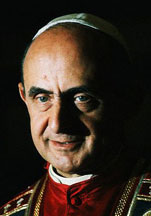
I was a junior in high school when Pope Paul VI died…was it really 32 years ago? Wow. It makes me sad to think it took so long for me to really appreciate and understand his legacy.

[powerpress url=”http://discerninghearts.com/Morning_Show/Karl_Schultz_Pope_Paul_VI.mp3″]Download (right click & choose “Save Link As”)
To really enter into his legacy, take a listen as Bruce and I discuss our late Holy Father w/ Karl Schultz, author of “Pope Paul VI: Christian Values and Virtures”, :
.
.
Tags: catholic, catholic podcast, catholic prayer, cathollc spirituality, humane vitae, karl schultz, pope paul vi
This entry was posted on Friday, August 6th, 2010 at 11:34 am
You can follow any responses to this entry through the RSS 2.0 feed.
Have you ever heard of “The Catholic Truth Society”? Well thanks to Ignatius Press, you  are about to. In this edition of “Inside the Pages”, I talk with Mark Brumley, president of Ignatius Press and whois one of the leading Catholic apologists in the country (he’s also a really nice guy as well). Ignatius Press is bringing the booklets, leaflets and tracks from the Society to America, and they’re fantastic. The authors found on these booklets are enough to crow about, but the titles are so good…wow…beyond excellent.  You don’t want to miss them. Take a look HERE! In this episode we talk the new evangelization, saints, history, apologetics…you name it.
are about to. In this edition of “Inside the Pages”, I talk with Mark Brumley, president of Ignatius Press and whois one of the leading Catholic apologists in the country (he’s also a really nice guy as well). Ignatius Press is bringing the booklets, leaflets and tracks from the Society to America, and they’re fantastic. The authors found on these booklets are enough to crow about, but the titles are so good…wow…beyond excellent.  You don’t want to miss them. Take a look HERE! In this episode we talk the new evangelization, saints, history, apologetics…you name it.
[powerpress]
Here are just some of the conversations Bruce and I have had with Mark Brumley in the past ![]()
Mark Brumley Did Jesus Really Rise.mp3
Mark Brumley Handbook of Catholic Apologetics.mp3
Mark Brumley Jesus of Nazareth Study Guide.mp3
Tags: catholic, catholic apologists, catholic podcast, catholic prayer, catholic truth society, cathollc spirituality, evangelization, ignatius press, inside the pages, mark brumley, mp3, new evangelization
This entry was posted on Thursday, July 22nd, 2010 at 10:26 am
You can follow any responses to this entry through the RSS 2.0 feed.
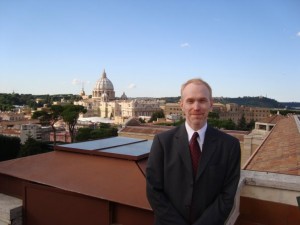 Here is part 2 of the discussion with Dr. Matthew Bunson, with the emphasis on the renewal and reform that has occured in the Church since the outbreak of the sexual abuse scandal. Dr. Bunson is once again EXCELLENT in articulating the problems which have surfaced, but also the response of the Church from its heart to the issue. It would be hard to find someone who does it better.
Here is part 2 of the discussion with Dr. Matthew Bunson, with the emphasis on the renewal and reform that has occured in the Church since the outbreak of the sexual abuse scandal. Dr. Bunson is once again EXCELLENT in articulating the problems which have surfaced, but also the response of the Church from its heart to the issue. It would be hard to find someone who does it better.
Dr. Bunson’s book can found at:
osv.com
[powerpress]
Tags: catholic, catholic podcast, catholic prayer, cathollc spirituality, inside the pages, matthew bunson, our sunday visitor, pope benedict xvi, sexual abuse, Sexual Abuse Scandal
This entry was posted on Thursday, July 15th, 2010 at 10:13 am
You can follow any responses to this entry through the RSS 2.0 feed.
For 100+ reasons, I love Dr. Matthew Bunson. No one I know has quite the depth of knowledge that he has and the ability to calmly disseminate it! His new book, co-authored with Gregory Erlandson, is OUTSTANDING! Please don’t say you have  formed your final opinion on this tragic period in Church history without reading “Pope Benedict XVI and the Sexual Abuse Crisis: Working for Reform and Renewal”. Don’t count on the secular media (and inparticular the NYT) to educate yourself on this matter. No one has done a better job chronicling this crisis and our Holy Father’s true response to this matter, then these two writers. The resources and prayers in the back of the book are excellent! Thank you Matthew and Gregory.
[powerpress]
Dr. Bunson’s book can found at:
osv.com
Dr. Bunson has been a frequent quest on Spirit Mornings with Bruce and Kris McGregor…check him out on the archives page! (I have got to him his own page soon…long, long overdue!!!!)
![]()
Tags: catholic, catholic podcast, catholic prayer, cathollc spirituality, erlandson, Gregory Erlandson, inside the pages, matthew bunson, mcgregor, our sunday visitor, pope benedict xvi, sexual abuse crisis
This entry was posted on Tuesday, July 13th, 2010 at 8:49 am
You can follow any responses to this entry through the RSS 2.0 feed.

